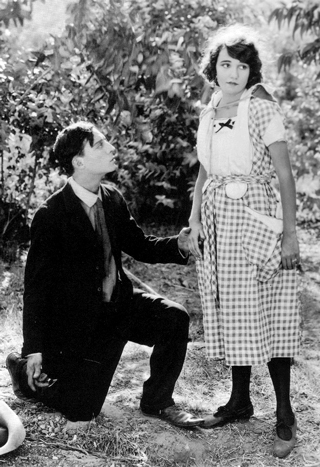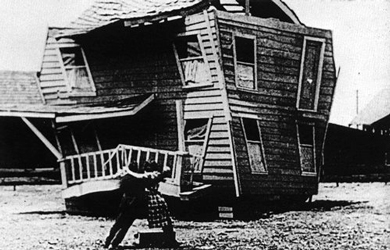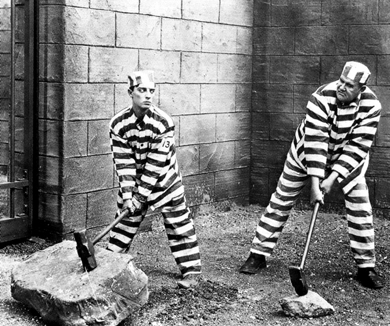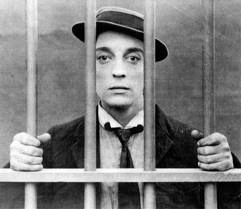
 |
|
|
|
We're accustomed to seeing Buster Keaton's early short films piecemeal, as a special treat on a screening schedule or as an extra for a silent comedy feature. Kino's Buster Keaton The Short Films Collection collects all nineteen of the independent two-reelers Keaton made between 1920 and 1923. Assembled in one group, the films show the screen comedian refining his solo persona and developing a style more dependent on realism than cartoonish gags. 
Coming directly from a productive apprenticeship with Fatty Arbuckle, Keaton was already adept with standard comedy material -- his pratfalls were the wildest on screen and no physical gag seemed too impossible for him. The Arbuckle-Keaton silent comedies are some of the funniest ever; we only wish that more of them existed in better-quality prints. Backer Joseph Schenck helped Buster move into Charles Chaplin's old Hollywood studio near the corner of Santa Monica Blvd. and Vine Street, where he began filming almost immediately. Keaton's nineteen shorts include oft-screened favorites and others not nearly as well known. The High Sign was filmed first but held up for a year because Keaton thought it was too much like an Arbuckle production. An extortion gang hires Buster to assassinate a businessman, who immediately hires Buster as a bodyguard. A bravura chase threads through a house rigged with a number of trap doors and secret passageways, the kind of technical challenge that appealed to Keaton and his head engineer- gag-builder, Fred Gabourie. Now recognized as his first solo masterpiece, Keaton's One Week takes silent comedy in a new direction. Its dry wit and physical logic immediately distinguish it from the frantic two-reelers by other comedians of 1920. Calendar pages count off the days as newlyweds cheerfully build a prefabricated house, not realizing that the assembly instructions have been sabotaged. The proud homeowners remain calm as the uninhabitable structure turns into a surreal nightmare. Keaton "tops" each crazy gag with one even more absurd, until the house meets its fate on some railroad tracks. 
One Week is core Keaton in that none of its jokes are blatantly impossible. When things go "crazy" in his filmic universe, the physicality of what occurs remains stubbornly logical: Buster is never hammered into the ground or chopped into pieces. Keaton disliked cartoonish gags, such as a bit in The High Sign where he hangs his jacket on a hook that he's drawn on the wall with chalk. His is a more honest struggle with the modern world. When Laurel & Hardy are mangled by shop tools or crushed by runaway pianos, we sometimes want the torture to stop. Keaton's energetic hero understands little of the forces that are ruining his plans, but he never howls or complains. The endless pursuit of Buster by an army of Cops therefore takes on an abstract quality. We laugh at individual stunts and marvel at the masses of uniforms that Buster seemingly cannot escape. Surrealists loved Keaton's innocent clashes with authority, and taken as a whole his films do make a whimsical artistic statement about the Human Condition. Many a Keaton hero ends up jailed or destitute, his boat sunk or his house destroyed, without ever really understanding what has happened. Some of Keaton's humor is downright sadistic. Convict 13 has plenty of black comedy, with guards and inmates shot and clubbed by the score; Buster stages several gags on a grim execution scaffold. Other short subjects are organized around interesting design ideas. Symmetrical backyards separated by a fence keep young lovers apart in Neighbors, but Buster visits his girl by climbing across second-story clotheslines. Buster's gags often involve visual illusions. In one film the bars of an iron gate fool us into thinking that he's in prison. In another, a spare tire that Buster hops on to hitch a ride turns out to be a display sitting on the ground, and not attached to the automobile. Keaton sets up his story with silent inter-titles but normally avoids verbal jokes. A telling exception is a gag in which a man wanders into a party covered in bandages. Another guest asks, "What happened to you?" He answers: "I bought a Ford." 
Keaton and his team loved elaborate mechanical gags. Functioning inventions adorn The Electric House, including a device that racks billiard balls. The Boat is practically a dry run for the director's later feature classic The Navigator. The voyage of the good ship Damfino is one disaster after another, even when Keaton's little dinghy remains tied up to the dock. The Playhouse is Keaton at his most surreal. Multiple exposures populate an entire musical theater -- actors, audience, musicians -- with duplicates of Buster Keaton. Several Keatons playing musical instruments interact perfectly; no mattes are visible. Technically, Keaton is forty years ahead of his time. In 1923 Schenck and the backers insisted that Keaton abandon short subjects and move up to the more profitable arena of feature film production. As we've already seen, his first feature effort Three Ages was organized to be easily split into three separate short subjects, should he prove unpopular in the longer format. Kino International's Blu-ray of Buster Keaton The Short Films Collection 1920-1923 is an archival-quality assembly. Only a couple of these 90 year-old gems are in perfect condition but all are presented at the best level of restoration so far attained. Once thought to be lost, the final short The Love Nest appears here in a reasonably good print. Day Dreams is missing several flashbacks, perhaps because they were printed on tinted film stock that deteriorated while the rest of the film remained intact. A couple of the shorts exist only in quality much poorer than the norm, and are included for the sake of completeness. The set comes on three separate Blu-ray discs, in order of filming. Each comedy has a newly recorded musical accompaniment. 
As is their policy, Kino has not used digital enhancement, as that process invariably softens the image as it minimizes visual flaws. But as an extra feature, five of the shorts (The High Sign, The Balloonatic, The Boat and Cops) have been run through digital processing. Curious viewers can compare the results for themselves. The ample extras provide a wealth of background information about this formative chapter in Keaton's career. Visual essays analyze fifteen titles, and are authored by experts including Bruce Lawton, David Kalat and Bret Wood. Keaton biographer Jeffrey Vance contributes an essay to the disc set's insert booklet. Locations expert John Bengtson details local sites where Keaton filmed. Vintage photos reveal most of Los Angeles in 1922 as empty acreage crisscrossed by dirt roads. A three-block strip of Cahuenga Blvd. saw a lot of Keaton production activity, as did a warren of downtown alleyways later wiped out by the Hollywood Freeway. Other menu choices lead viewers to alternate and deleted scenes, with a generous helping of related films by other silent comedians.
On a scale of Excellent, Good, Fair, and Poor,
Buster Keaton The Short Films Collection 1920-1923 Blu-ray rates:
Reviews on the Savant main site have additional credits information and are often updated and annotated with reader input and graphics. Also, don't forget the 2010 Savant Wish List. T'was Ever Thus.
Review Staff | About DVD Talk | Newsletter Subscribe | Join DVD Talk Forum |
| ||||||||||||||||||